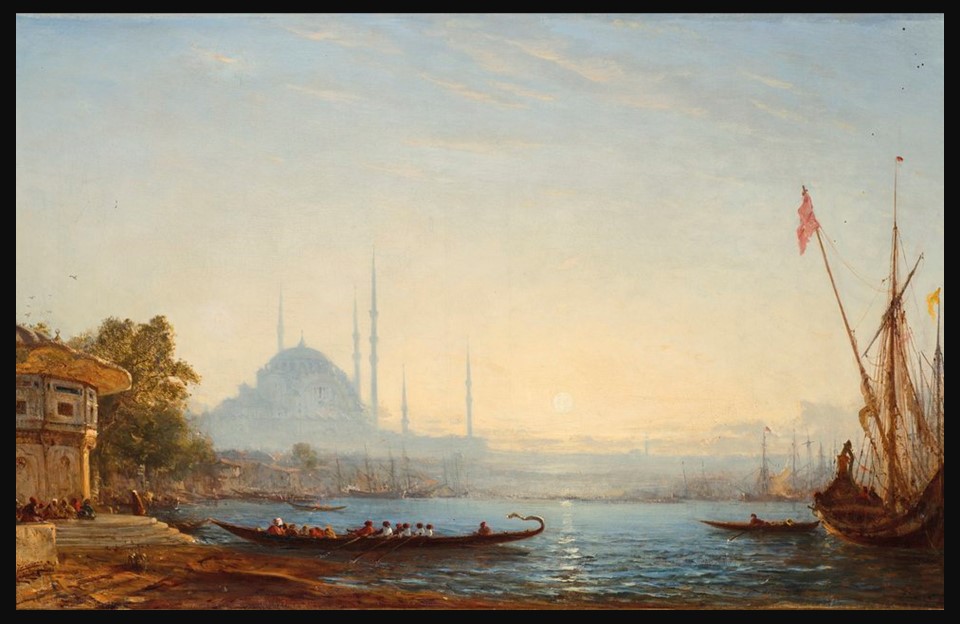
Constantinople, 1857-58, Oil on Canvas, 58 x 93.4 cm, Private Collection
https://www.christies.com/en/private-sales/privateitems/private-item-SN00656940-001
…Once out of nature I shall never take / My bodily form from any natural thing, / But such a form as Grecian goldsmiths make / Of hammered gold and gold enamelling / To keep a drowsy Emperor awake; / Or set upon a golden bough to sing / To lords and ladies of Byzantium / Of what is past, or passing, or to come. The closing lines of W. B. Yeats’s poem Sailing to Byzantium, and Félix Ziem’s painting of Constantinople both engage with the East as an idealized realm of transcendence and beauty, albeit in different artistic forms. Yeats’ Byzantium is a symbolic place of spiritual and artistic immortality, where the soul escapes the physical decay of old age and achieves eternal wisdom. In a parallel way, Ziem’s depiction of Constantinople offers a romanticized vision of the East, reflecting the 19th-century Orientalist fascination with the exotic and timeless aspects of the Orient. Both works use their respective mediums to transport the audience to an imagined, heightened version of the East.
The Orientalist connection between these works lies in their idealization of the East as a space of otherness, mystery, and eternal allure. While Yeats uses Byzantium as a metaphor for personal and artistic transcendence, Ziem’s Constantinople fits into the broader Orientalist tradition of presenting the East as a visually stunning and dreamlike world. Both artists, in their ways, construct the East as a place removed from mundane reality, where beauty and spiritual richness abound. Their works capture the Western artistic fascination with the Orient as a realm of wonder and aesthetic fulfilment.
Félix Ziem (1821–1911) was a French painter known for his vivid, atmospheric landscapes and maritime scenes, often depicting exotic locales. Born in Beaune, France, Ziem initially studied architecture before turning to painting, a transition that shaped his skilful rendering of urban spaces and architectural details in his artwork. He became associated with the Barbizon School, a movement that focused on naturalistic depictions of rural life. Still, Ziem’s works often took a different path, leaning toward the fantastical and picturesque. His fascination with travel and the allure of distant places led him to explore Venice, the Mediterranean, and especially the Ottoman Empire, particularly Constantinople (modern-day Istanbul). These experiences fueled his work, making him a significant figure in the Orientalist movement, which romanticized and idealized the East in Western art.
Ziem’s mastery of light and colour, combined with his ability to evoke the grandeur and mystique of foreign landscapes, earned him widespread acclaim during his lifetime. He exhibited frequently at the Paris Salon and achieved considerable financial success, an unusual feat for a 19th-century artist. Ziem was admired for his skill in capturing the shimmering waters and golden light of the Mediterranean, particularly in his Venetian and Constantinople scenes, which remain some of his most famous works. His love for travel and exploration is reflected in the dreamlike quality of his paintings, which often blur the line between reality and romantic fantasy. In 1908, he was awarded the prestigious honour of being inducted into the French Academy of Fine Arts.
Félix Ziem’s painting Constantinople captures the vibrancy and grandeur of the Ottoman capital through a masterful blend of light, colour, and architectural detail. The painting offers a panoramic view of the city’s waterfront, where the sparkling waters of the Golden Horn meet the bustling harbour, and boats glide gracefully along. Dominating the skyline is the majestic silhouette of domes and minarets, including the iconic Hagia Sophia, bathed in the warm, golden glow of the setting sun. Ziem’s brushwork evokes the atmosphere of a city alive with activity and culture, yet shrouded in a dreamlike haze that enhances its exotic appeal. The luminous sky and shimmering reflections on the water create a sense of serenity and timelessness, presenting Constantinople not just as a geographical location but as a symbol of the alluring, mystical East. Ziem’s portrayal invites the viewer into a romanticized vision of the city, where everyday life blends with the grandeur of empire and the beauty of the natural world.
For a PowerPoint Presentation of Félix Ziem’s oeuvre, please… Check HERE!
Bibliography: https://www.christies.com/en/private-sales/privateitems/private-item-SN00656940-001